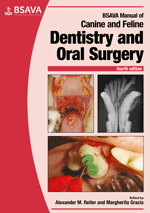
Full text loading...

This chapter provides information about dental and oral pathologies commonly encountered in cats and dogs, including periodontal disease, gingival enlargement, autoimmune conditions, abnormal number and morphology of teeth, abnormal eruption of teeth, malocclusion, hard tissue defects, tooth displacement, jaw fracture, soft tissue injury, abnormalities of the palate and salivary gland pathology.
Commonly encountered dental and oral pathologies, Page 1 of 1
< Previous page | Next page > /docserver/preview/fulltext/10.22233/9781905319602/9781905319602.5-1.gif

Full text loading...






































































